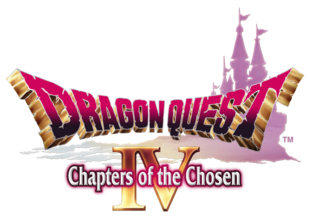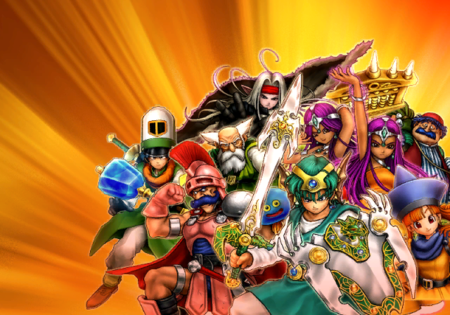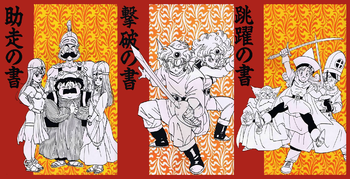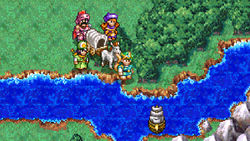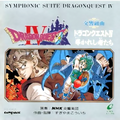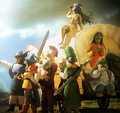Dragon Quest IV: Chapters of the Chosen: Difference between revisions
Limp Bizkit (talk | contribs) m (→Setting: almost thought that said /v/) |
Limp Bizkit (talk | contribs) m (→Prologue: We?) |
||
| Line 35: | Line 35: | ||
:''Main article: [[Dragon Quest IV Prologue|Prologue]]'' | :''Main article: [[Dragon Quest IV Prologue|Prologue]]'' | ||
Introduces [[Hero (Dragon Quest IV)|Hero]] and his/her friend [[Eliza]]. This portion of the story was introduced in the PlayStation version, and became standard in later remakes. | |||
===Chapter 1=== | ===Chapter 1=== | ||
Revision as of 13:30, 16 May 2020
| Main series games | |
|---|---|
| Chapters of the Chosen | |
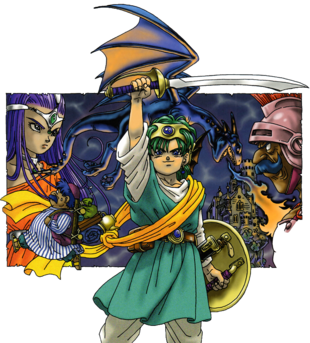
| |
| Developer(s) | Chunsoft Heartbeat, ArtePiazza (PS) ArtePiazza, Cattle Call(NDS) |
| Publisher(s) | Enix Square Enix (NDS) |
| Designer(s) | Yūji Horii |
| Artist(s) | Akira Toriyama |
| Composer(s) | Kōichi Sugiyama |
| Series | Dragon Quest |
| Platform(s) | Nintendo Entertainment System, Famicom, Sony PlayStation, Nintendo DS, Android & iOS |
| Release date(s) | Famicom/NES JP February 11, 1990 NA October 1992 PlayStation JP November 22, 2001 Nintendo DS JP November 22, 2007 NA September 16, 2008 EU September 12, 2008 AUS September 11, 2008 Android & iOS JP April 17, 2014 NA August 7, 2014 |
| Genre(s) | Console role-playing game |
| Mode(s) | Single-player |
| Rating(s) | CERO: A (PS1, DS) ESRB: E10+ (DS) OFLC: PG |
| Media | 4-megabit NES cartridge CD (PS1) Nintendo DS Game Card |
Dragon Quest IV (ドラゴンクエストIV 導かれし者たち Doragon Kuesuto Fō Michibikareshi Monotachi, literally meaning; The People Who Are Shown the Way) is a role-playing game and the fourth installment of the Dragon Quest video game series. The game was originally released for the NES, but has been remade several times for different systems. It begins the Tenkuu (Celestial) trilogy, known better as the Zenithian trilogy in English.
It was originally released for the Famicom on February 11, 1990 in Japan. The North American version, titled Dragon Warrior IV, was released for the NES in October 1992.
Setting
Dragon Quest IV is the first of the series to not be related to the lineage of Erdrick--the game is the first of a new trilogy revolving around the legend of a castle in the sky that watches over the world below. The world map is of a comparable size to that of III, but has no direct parallels to the real world in regards to the shape of the continents and nature of the kingdoms.
Plot
The story in IV is a more character-focused tale centered around the lives of the chosen ones prior to and during their quest to prevent the resurrection of the ruler of evil, Estark. The first four chapters of the story are about the hero's companions and their own challenges and hardships. While they each travel with their own goals and dreams in mind, they all eventually discover the conspiracy of Psaro the Manslayer to drive the human race to extinction via Estark's hellish power.
Prologue
- Main article: Prologue
Introduces Hero and his/her friend Eliza. This portion of the story was introduced in the PlayStation version, and became standard in later remakes.
Chapter 1
- Main article: Chapter 1
Ragnar McRyan, one of the soldiers in the royal palace of Burland, is sent by the king on a journey to find out why children are disappearing across the kingdom.
Chapter 2
- Main article: Chapter 2
Alena, princess (Tsarevna in the Nintendo DS localization) of Zamoksva, who slips out of the castle in hopes of seeing the world that exists beyond the castle walls. She is accompanied by the priest Kiryl and the mage Borya.
Chapter 3
- Main article: Chapter 3
Torneko Taloon lives in Lakanaba with his wife and son, and works part-time in the local weapon shop. He aims to become the best merchant in the world, and begins his chapter in search of a regional treasure that could help him accomplish his goal.
Chapter 4
- Main article: Chapter 4
Maya Mahabala the dancer and her younger sister Meena Mahabala, the fortune teller, have left Laissez Fayre in search of vengeance against Balzack, their father's traitorous apprentice.
Chapter 5
- Main article: Chapter 5
The Hero has been brought up by the inhabitants of a remote and nameless mountain village. But Psaro and his legions destroy the village, leaving only the hidden hero alive. The hero leaves in search of his seven companions, in the hopes of defeating Psaro and saving the world.
Chapter 6
- Main article: Chapter 6
Chapter 6 is a post-epilogue continuation of the game's storyline. Originally appearing in the PlayStation remake of Dragon Quest IV, Chapter 6 offers a lengthy bonus dungeon, and the culmination of certain plot points that were left ambiguous in the original release.
New features
Artificial intelligence
In a bold move for an NES title, a significant portion of the game's memory was dedicated to an intricate artificial intelligence that controls party members during the fifth chapter. In the fifth chapter of the NES version of the game, the player no longer directly controls any of the previous characters; instead using the Tactics menu to deliver a loose set of instructions (Normal, Defensive, Offensive, Save MP, Use No MP, Try Out). The only character directly controlled is the Hero. All chapters except chapter 2 also contain Non-Player Characters, which travel with the player, but cannot be directly controlled. They act on their own, guided by the game's AI.
Party expansion
- Every chapter save the second includes a non-chosen party member who will assist the group temporarily during their travels together. Each is tied to a story element of the chapter and reflect that section of the story's tone.
- A wagon was implemented to transport up to eight party members at the same time, allowing for battle configurations to be rearranged to suit any encounter at will. Certain dungeons will not allow the wagon to enter the area, however.
Collectibles
- Mini medals are scattered throughout the world for the player to gather at their leisure, which can be exchanged for incredible equipment at the palace of the Medal King.
- Items are now hidden in drawers, cabinets, and urns in addition to chests. Contents range from stat boosting seeds to common item and small sums of gold.
Casino
Building upon the gambling featured in the monster arenas of III, the fourth game allows players to explore a large casino in the city of Endor. Redeemable tokens can be won at slot machines, poker, and monster betting, which can be spent on exclusive items and equipment.
Legacy
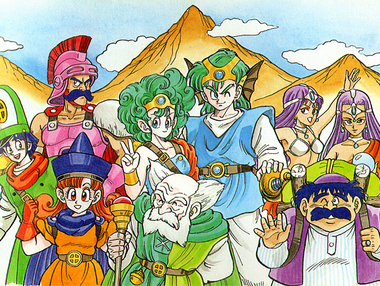
Remakes
Dragon Quest IV was remade for the Sony PlayStation on November 22, 2001 in Japan. It was developed by Heartbeat and published by Enix. The remake was developed using Dragon Quest VII: Fragments of the Forgotten Past 's 3D graphics engine. With this remake came new features; among them were a new chapter, a new character, a boom town reminiscent of VII's, an inter-party talk command similar to Dragon Quest VII, and the ability to turn off the artificial intelligence for party members. The Enix of America Corporation originally planned to bring the remake to North America in 2002, but it was later cancelled due to Heartbeat closing its video game development operations.
On November 22, 2007, this PlayStation remake was ported to the Nintendo DS. No significant changes were made to the game's story, gameplay, or bonus features, aside from modifying the boom town's immigration aspects to reflect the lack of memory cards in the DS hardware and the calculation method for Alena's Critical Hits. The Fungeon (bonus dungeon) changed it's layout to random locations for each floor, whereas the PlayStation Version was a mix of previous areas from the game and from Dragon Quest VII: Fragments of the Forgotten Past. This portable version was released internationally in September of 2008, but without the party chat feature. This was due to square enix's uncertainty regarding the reception of the title, and the budget to translate the two-thirds of the script that the chat contained was slashed. However, the international release performed well and the budget for localization was expanded to allow the feature to be retained in V and VI.
On April 7, 2014, the PlayStation remake was ported to iOS and Android compatible devices. This version features significantly sharper graphics than before, as well as a fully orchestrated soundtrack. No significant gameplay changes were made aside from yet another tweaking of the Tsarevna's critical hit ratio, and a slight change adding a detour in the boom town development. The bonus dungeon layout from the DS port was retained. This version was released world wide on August 7, 2014, and most importantly restored the long-lost party chat to much critical acclaim.
Sequels
Dragon Quest V: Hand of the Heavenly Bride has some references to Dragon Quest IV: Chapters of the Chosen, but is mostly an independent story that does not heavily rely on the previous entry. The adventure of the chosen is known only by a scant few individuals, which further separates the Zenithian trilogy from it's predecessor.
Soundtrack
Kōichi Sugiyama composed the music and directed all the associated spin-offs. This is the track listing of the Symphonic Suite:
- Overture (1:55)
- Minuet (3:07)
- Comrades (10:28)
- In a Town (8:16)
- Homeland ~ Wagon Wheels' March (5:58)
- Frightening Dungeons ~ Cursed Towers (5:19)
- Elegy ~ Mysterious Shrine (5:03)
- Balloon's Flight (4:32)
- Sea Breeze (4:31)
- The Unknown Castle (4:37)
- Battle for the Glory (7:51)
- The End (5:12)
Version differences
PS remake
DS
- The Nintendo DS remake uses nearly the same style as the PS Version, with some minor compression to account for the handheld's screen size.
- The Pioneer Town lacks the variants of the PS Version due to replacing recruitable NPCs with ones that can be found after a certain point in game (see the article for more details).
- The floors of the Fungeon are made up of new designs rather than from previous areas in the game, as well as Dragon Quest VII: Fragments of the Forgotten Past.
- Mild profanity such as damnedest, hell, helliva is used in the DS, Android, iOS versions of the game.
- The DS uses 2 separate screens in the game, the top screen displaying the map and the heroes' battle information.
- Religious references that were removed from the NES Version are now included in the game.
- Name changes to Weapons, Armor, items.
Mobile changes
In addition to the changes from the previous two versions, the smartphone port adds the following:
- The Android and iOS uses touch screen features and the game uses a portrait screen setting instead of the landscape screen.
- Zoom and Evac's MP cost have been reduced to 1 MP each.
- The immigrant town's upgrade requirements have been slightly tweaked, requiring more townsfolk to be recruited per stage of development.
See also
Gallery
Title Screens
Box art
Original artwork of the Famicom release.
NES box art.
Nintendo DS box art.
Miscellaneous
External links
